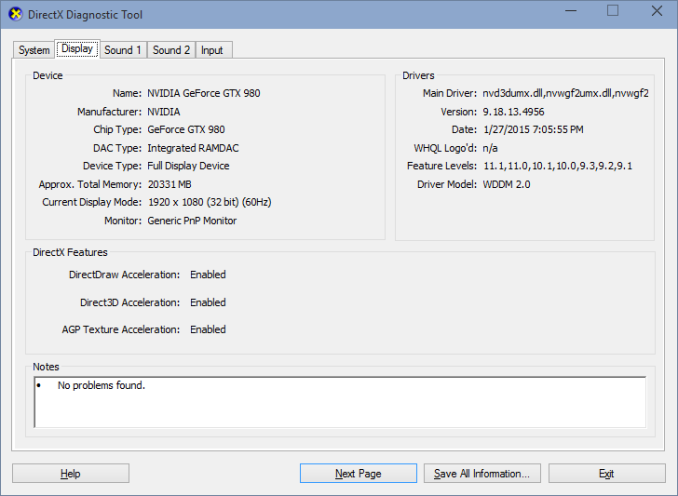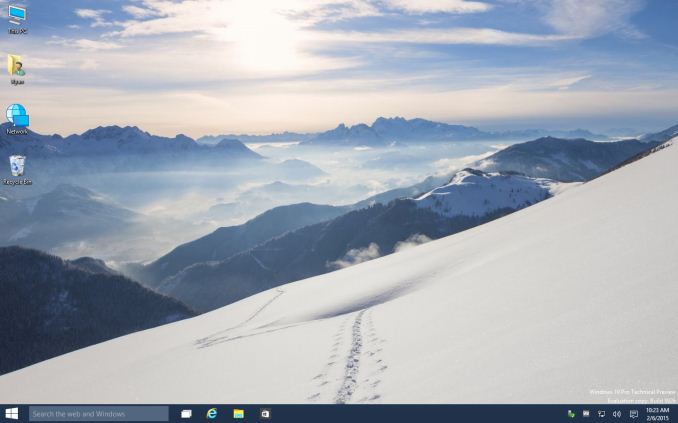The DirectX 12 Performance Preview: AMD, NVIDIA, & Star Swarm
by Ryan Smith on February 6, 2015 2:00 PM EST- Posted in
- GPUs
- AMD
- Microsoft
- NVIDIA
- DirectX 12
The Current State of DirectX 12 & WDDM 2.0
Although DirectX 12 is up and running in the latest public release of Windows 10, it and many of its related components are still under development. Windows 10 itself is still feature-incomplete, so what we’re looking at here today doesn’t even qualify as beta software. As a result today’s preview should be taken as just that: an early preview. There are still bugs, and performance and compatibility is subject to change. But as of now everything is far enough along that we can finally get a reasonable look at what DirectX 12 is capable of.
From a technical perspective the DirectX 12 API is just one part of a bigger picture. Like Microsoft’s last couple of DirectX 11 minor version upgrades, DirectX 12 goes hand-in-hand with a new version of the Windows Display Driver Model, WDDM 2.0. In fact WDDM 2.0 is the biggest change to WDDM since the driver model was introduced in Windows Vista, and as a result DirectX 12 itself represents a very large overhaul of the Windows GPU ecosystem.
Top: Radeon R9 290X. Bottom: GeForce GTX 980
Microsoft has not released too many details on WDDM 2.0 so far – more information will be released around GDC 2015 – but WDDM 2.0 is based around enabling DirectX 12, adding the necessary features to the kernel and display drivers in order to support the API above it. Among the features tied to WDDM 2.0 are DX12’s explicit memory management and dynamic resource indexing, both of which wouldn’t have been nearly as performant under WDDM 1.3. WDDM 2.0 is also responsible for some of the baser CPU efficiency optimizations in DX12, such as changes to how memory residency is handled and how DX12 applications can more explicitly control residence.
The overhauling of WDDM for 2.0 means that graphics drivers are impacted as well as the OS, and like Microsoft, NVIDIA and AMD have been preparing for WDDM 2.0 with updated graphics drivers. These drivers are still a work in progress, and as a result not all hardware support is enabled and not all bugs have been worked out.
| DirectX 12 Support Status | ||||
| Current Status | Supported At Launch | |||
| AMD GCN 1.2 (285) | Working | Yes | ||
| AMD GCN 1.1 (290/260 Series) | Working | Yes | ||
| AMD GCN 1.0 (7000/200 Series) | Buggy | Yes | ||
| NVIDIA Maxwell 2 (900 Series) | Working | Yes | ||
| NVIDIA Maxwell 1 (750 Series) | Working | Yes | ||
| NVIDIA Kepler (600/700 Series) | Working | Yes | ||
| NVIDIA Fermi (400/500 Series) | Not Active | Yes | ||
In short, among AMD and NVIDIA their latest products are up and running in WDDM 2.0, but not on all of their earlier products. In AMD’s case GCN 1.0 cards are supported under their WDDM 2.0 driver, but we are encountering texturing issues in Star Swarm that do not occur with GCN 1.1 and later. Meanwhile in NVIDIA’s case, as is common for NVIDIA beta drivers they only ship with support enabled for their newer GPUs – Kepler, Maxwell 1, and Maxwell 2 – with Fermi support disabled. Both AMD and NVIIDA have already committed to supporting DirectX 12 (and by extension WDDM 2.0) on GCN 1.0 and later and Fermi and later respectively, so while we can’t test these products today, they should be working by the time DirectX 12 ships.
Also absent for the moment is a definition for DirectX 12’s Feature Level 12_0 and DirectX 11’s 11_3. Separate from the low-level API itself, DirectX 12 and its high-level counterpart DirectX 11.3 will introduce new rendering features such as volume tiled resources and conservative rasterization. While all of the above listed video cards will support the DirectX 12 low-level API, only the very newest video cards will support FL 12_0, and consequently be fully DX12 compliant on both a feature and API basis. Like so many other aspects of DirectX 12, Microsoft is saving any discussion of feature levels for GDC, at which time we should find out what the final feature requirements will be and which (if any) current cards will fully support FL 12_0.
Finally, with Microsoft’s announcement of their Windows 10 plans last month, Microsoft is also finally clarifying their plans for the deployment of DirectX 12. Because DirectX 12 and WDDM 2.0 are tied at the hip, and by extension tied to Windows 10, DirectX 12 will only be available on Windows 10. Windows 8/8.1 and Windows 7 will not be receiving DirectX 12 support.
| DirectX 12 Supported OSes | ||||
| Will Support DX12? | Required WDDM Version | |||
| Windows 10 | Yes | 2.0 | ||
| Windows 8.1 | No | N/A | ||
| Windows 8 | No | N/A | ||
| Windows 7 | No | N/A | ||
Backporting DirectX 12 to earlier OSes would require backporting WDDM 2.0 as well, which brings with it several issues due to the fact that WDDM 2.0 is a kernel component. Microsoft would either have to compromise on WDDM 2.0 features in order to make it work on these older kernels, or alternatively would have to more radically overhaul these kernels to accommodate the full WDDM 2.0 feature set, the latter of which is a significant engineering task and carries a significant risk of breaking earlier Windows installations. Microsoft has already tried this once before in backporting parts of Direct3D 11.1 and WDDM 1.2 to Windows 7, only to discover that even that smaller-scale project had compatibility problems. A backport of DirectX 12 would in turn be even more problematic.
The bright side of all of this is that with Microsoft’s plans to offer Windows 10 as a free upgrade for Windows 7/8/8.1 users, the issue is largely rendered moot. Though DirectX 12 isn’t being backported, Windows users will instead be able to jump forward for free, so unlike Windows 8 this will not require spending money on a new OS just to gain access to the latest version of DirectX. This in turn is consistent with Microsoft’s overall plans to bring all Windows users up to Windows 10 rather than letting the market get fragmented among different Windows versions (and risk repeating another XP), so the revelation that DirectX 12 will not get backported has largely been expected since Microsoft’s Windows 10 announcement.
Meanwhile we won’t dwell on the subject too much, but DirectX 12 being limited to Windows 10 does open up a window of opportunity for Mantle and OpenGL Next. With Mantle already working on Windows 7/8 and OpenGL Next widely expected to be similarly portable, these APIs will be the only low-level APIs available to earlier Windows users.













245 Comments
View All Comments
loguerto - Saturday, February 7, 2015 - link
Microsoft is on the right way, but still, Mantle is the boss!FXi - Saturday, February 7, 2015 - link
I'm sadly more curious as to whether the 6 core chips prove their worth. A lot of rumor guessing seems to think that DX12 might finally show that a 6 core matters, but nothing here shows that. That's a very key issue when it comes to whether to go for a higher end chip or stick with the 4 core cpu's.GMAR - Saturday, February 7, 2015 - link
Excellent article. Thank you!Shahnewaz - Saturday, February 7, 2015 - link
Wait a minute, isn't the GTX 980 a 165W TDP card? Then how is it pulling over 200 watts?eRacer1 - Sunday, February 8, 2015 - link
The GTX 980 isn't pulling over 200W. The numbers shown are system power consumption not video card power consumption. The GTX 980 system power consumption isn't unusually high.Also, the system power consumption numbers are understating the power difference between the GTX 980 and Radeon 290X cards themselves under DX12. The GTX 980 has such a large performance advantage over the 290X in DX12 that the CPU is also using more power in the GTX 980 system to keep up with the video card.
If anything the 290X power consumption is "too low", especially under DX12. To me it looks like the GPU is being underutilized, which seems to be the case based on the low FPS results and power consumption numbers. That could be due to many reasons: poor driver optimization, 290X architectural limitations, benchmark bug or design choice, Windows 10 issue, 290X throttling problem, etc. Hopefully, for AMD's sake, those issues can be worked out before the Windows 10 launch.
Shahnewaz - Sunday, February 8, 2015 - link
That doesn't explain the <20W difference in both systems.And it's not like the CPU usage is also radically different.
Remember, the TDP difference between the GPUs is a massive 165W (290W vs 165W).
eRacer1 - Sunday, February 8, 2015 - link
"That doesn't explain the <20W difference in both systems. And it's not like the CPU usage is also radically different."Looking at the CPU usage graphs in the review the GTX 980 DX12 CPU average across all four cores is about 80% while the 290X average is only about 50%. So the GTX 980 CPU is doing 60% more work. That alone could easily account for 20+W watts of extra power consumption on CPU in the GTX 980 system. The ~60% CPU higher usage in the GTX 980 system makes sense as the frame rate is 56% higher as well. So what looks like a 14W difference is probably more like a 35W difference between the GTX 980 and 290X video cards.
But the 35W difference doesn't tell the whole story because the GTX 980 is also 56% faster while using less power. So the GTX 980 has a MASSIVE efficiency advantage under these benchmark conditions. And it is doing it within a reasonable TDP because by the time you back out all of the non-GPU power consumption (CPU, memory, motherboard, hard drive, fans, etc.) and PSU inefficiency losses from the 271W system power consumption you'd likely find that the GTX 980 is under 200W.
So the question we are left with is why is a 290W TDP 290X system power consumption only 285W under DX12? By the time you subtract the CPU power consumption (which is somewhat less than that of the GTX 980 test due to only being at 50% load instead of 80%), motherboard, memory and other components the 290X is probably using only 200-220W. To me it looks like the 290X is being bottlenecked and as a result isn't using as much power as one would expect. What the source of the bottleneck is, and if it is correctable, remains a mystery.
Shahnewaz - Saturday, February 7, 2015 - link
It looks like AMD GPUs will get some 400%+ performance improvements! Sick!ET - Sunday, February 8, 2015 - link
My main takeaway from the article is that NVIDIA has done a much better job of optimising its DX11 drivers. AMD needs low level badly.bloodypulp - Sunday, February 8, 2015 - link
They already have it: Mantle.